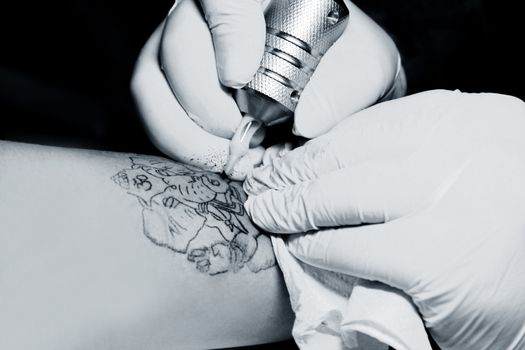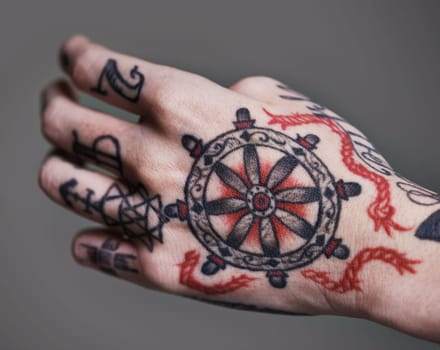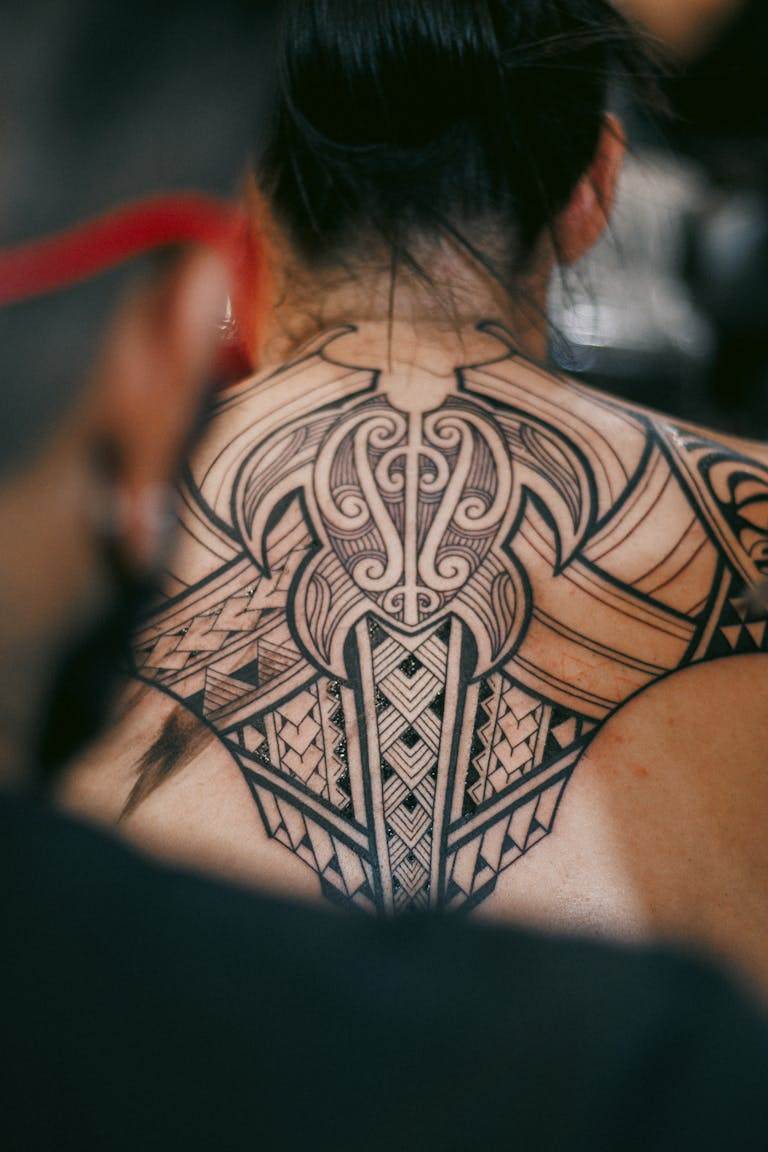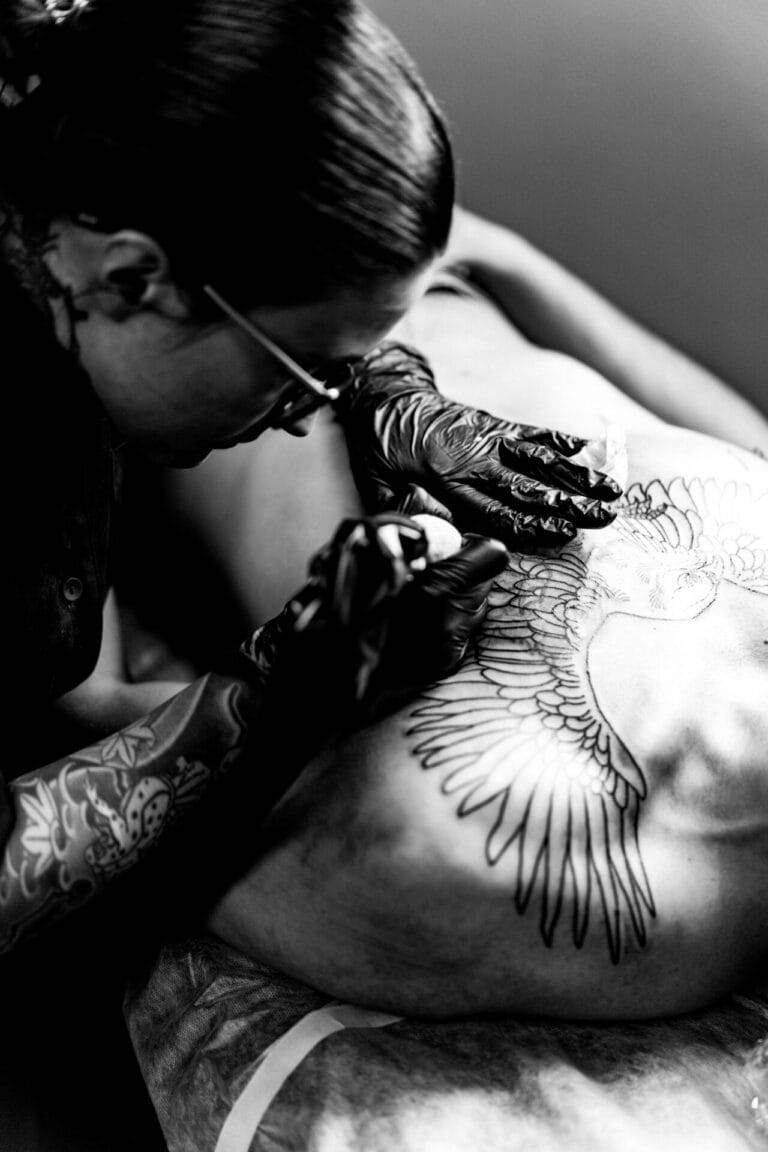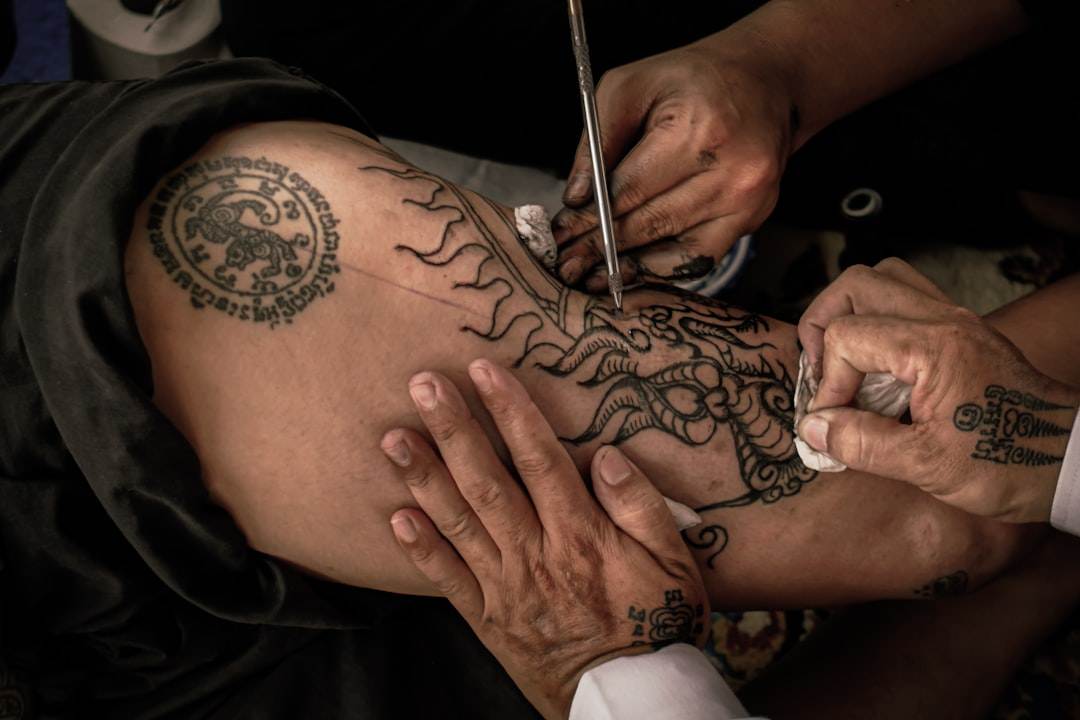
The tattoo process begins with the creation of a stencil, a crucial step that lays the groundwork for the entire artwork. The stencil serves as a guide for the tattoo artist, ensuring that the design is accurately transferred onto the skin. This initial phase involves taking a detailed design and reproducing it onto a special transfer paper.
The artist may use various methods to create the stencil, including freehand drawing or using digital tools to print the design. The precision of this step is vital, as it dictates how well the final tattoo will align with the client’s vision. Once the stencil is prepared, it is carefully applied to the skin.
The artist cleans the area and uses a transfer solution to ensure that the stencil adheres properly. This process requires skill and attention to detail, as any misalignment can lead to an unsatisfactory outcome. After applying the stencil, the artist will often ask for feedback from the client to confirm that the placement and size are correct.
This collaborative approach not only helps in achieving the desired result but also builds trust between the artist and the client, setting a positive tone for the rest of the tattooing experience.
Key Takeaways
- Understanding the stencil is the first step in the tattoo process, ensuring the design is accurately transferred onto the skin.
- Choosing the right ink is crucial for a high-quality tattoo, as it affects the longevity and vibrancy of the design.
- The art of tattooing involves various techniques and tools, such as shading and outlining, to create a visually appealing tattoo.
- The healing process is essential for caring for your tattoo after it’s done, including proper cleaning and moisturizing to promote healing and prevent infection.
- Customization and collaboration with your tattoo artist are key in creating the perfect design that reflects your personal style and vision.
Choosing the Right Ink: The Importance of Quality in the Tattoo Process
The choice of ink is another critical aspect of the tattooing process that can significantly impact the final result. High-quality tattoo ink is essential for achieving vibrant colors and long-lasting designs. Unlike lower-quality inks, which may fade or cause allergic reactions, premium inks are formulated to be safe and stable on the skin.
Artists often have their preferred brands, which they trust for their consistency and reliability. When selecting ink, factors such as pigment quality, viscosity, and lightfastness come into play, all of which contribute to how well the tattoo will age over time. Moreover, understanding the different types of ink available can help clients make informed decisions.
For instance, some inks are specifically designed for black and gray tattoos, while others are formulated for bright colors. Additionally, vegan and organic inks have gained popularity among those who are conscious about ingredients and environmental impact. By discussing ink options with their tattoo artist, clients can ensure that their chosen design not only looks stunning but also aligns with their values regarding health and sustainability.
The Art of Tattooing: Techniques and Tools Used in the Process
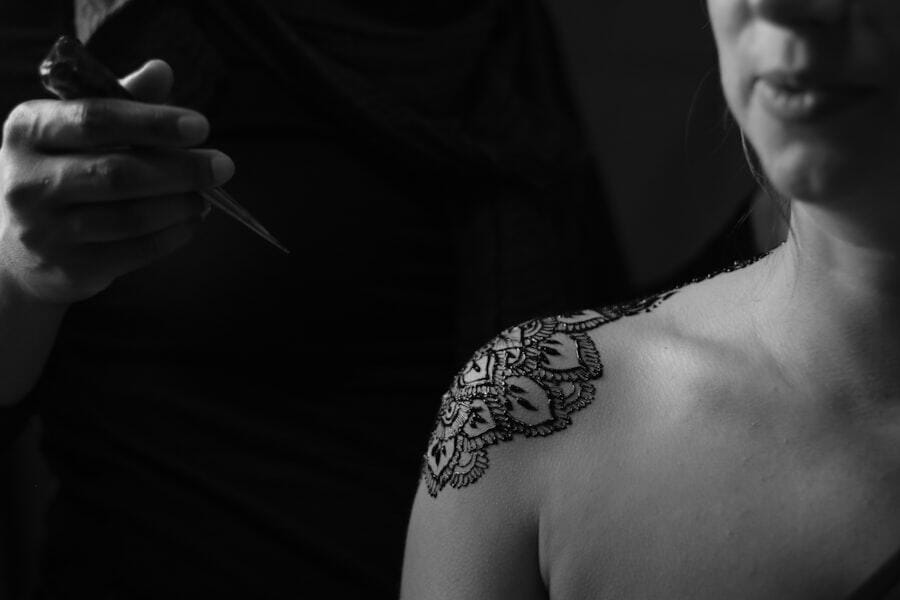
Tattooing is an intricate art form that combines creativity with technical skill. Artists employ various techniques to bring designs to life, each requiring a unique set of tools and expertise. One of the most common methods is using a rotary or coil tattoo machine, which allows for precise control over needle depth and speed.
The choice of machine often depends on the style of tattoo being created; for example, coil machines are favored for traditional styles, while rotary machines are preferred for fine line work. In addition to machines, artists utilize a range of needles designed for different effects. Liner needles create crisp outlines, while shader needles are used for filling in colors and adding depth.
The selection of needles can greatly influence the texture and appearance of the tattoo. Furthermore, artists often incorporate techniques such as stippling or whip shading to add dimension and detail to their work. Mastery of these techniques is what distinguishes skilled tattoo artists from novices, as it requires years of practice and a deep understanding of how ink interacts with skin.
The Healing Process: Caring for Your Tattoo After it’s Done
Once the tattoo is complete, the healing process begins, which is crucial for ensuring that the artwork remains vibrant and intact. Proper aftercare is essential during this period, as it can significantly affect how well the tattoo heals and looks in the long run. Immediately after getting inked, clients are typically advised to keep the area clean and covered with a sterile bandage for a few hours.
This initial protection helps prevent infection and allows the skin to start healing without interference. As healing progresses, clients should follow specific aftercare instructions provided by their tattoo artist. This often includes gently washing the tattoo with mild soap and water, applying a thin layer of fragrance-free moisturizer or ointment, and avoiding direct sunlight or soaking in water for extended periods.
It’s important to resist the urge to scratch or pick at scabs that may form during healing, as this can lead to scarring or color loss. By adhering to these guidelines, clients can help ensure that their tattoos heal beautifully and maintain their intended appearance.
Customization and Collaboration: Working with Your Tattoo Artist to Create the Perfect Design
One of the most exciting aspects of getting a tattoo is the opportunity for customization. Collaborating with a tattoo artist allows clients to express their individuality through unique designs that resonate with their personal stories or aesthetics. During initial consultations, clients can share their ideas, inspirations, and any specific elements they wish to incorporate into their tattoos.
This open dialogue fosters creativity and ensures that both parties are aligned on expectations. Tattoo artists often bring their own artistic flair to the table, suggesting modifications or enhancements that can elevate the design further. This collaborative process may involve sketching out concepts or making adjustments based on feedback until both the client and artist are satisfied with the final design.
Such partnerships not only result in stunning tattoos but also create a sense of ownership for clients over their body art. Ultimately, this synergy between artist and client is what transforms a simple idea into a meaningful piece of art.
The Role of Pain Management: Tips for Making the Tattoo Process More Comfortable
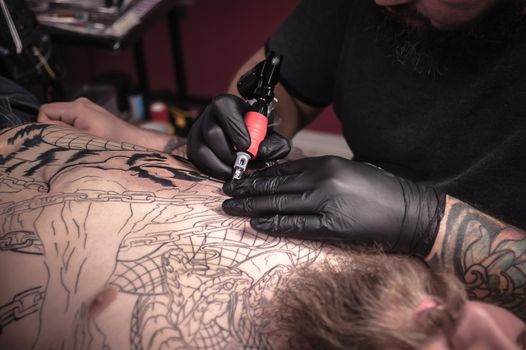
Getting a tattoo can be an uncomfortable experience, but there are several strategies that clients can employ to manage pain effectively. Understanding that pain tolerance varies from person to person is essential; what may be mildly uncomfortable for one individual could be excruciating for another. To prepare for a session, clients should consider factors such as hydration and nutrition, as being well-nourished can help mitigate discomfort during the process.
Additionally, many artists recommend using topical numbing creams before starting a tattoo session. These creams can significantly reduce sensitivity in the area being worked on, making it easier for clients to endure longer sessions without excessive discomfort. Breathing techniques and mindfulness practices can also be beneficial; focusing on deep breaths can help distract from pain and create a more relaxed atmosphere during the procedure.
Ultimately, open communication with the artist about pain levels throughout the session can lead to adjustments in technique or breaks as needed.
The Final Touches: Adding Shading and Detail to Complete the Tattoo
As a tattoo nears completion, artists often focus on adding shading and intricate details that bring depth and dimension to the design. Shading techniques can transform a flat image into a three-dimensional work of art by creating contrasts between light and dark areas. Artists may use various methods such as gradient shading or dot work to achieve different effects depending on the desired outcome.
The addition of details—such as highlights in certain areas or fine line work—can elevate a tattoo from good to exceptional. These final touches require a keen eye for detail and an understanding of how light interacts with surfaces. Artists often take their time during this stage to ensure that every aspect aligns perfectly with their vision and that of their client.
This meticulous approach not only enhances the overall aesthetic but also solidifies the tattoo’s significance as a personal expression.
Long-Term Care: Maintaining the Quality and Appearance of Your Tattoo Over Time
Once healed, maintaining a tattoo’s quality requires ongoing care and attention. Over time, factors such as sun exposure, skin type, and aging can affect how tattoos look. To preserve vibrancy, clients should apply sunscreen on their tattoos whenever exposed to sunlight; UV rays can cause fading and discoloration over time.
Additionally, moisturizing regularly helps keep skin healthy and supple, which in turn supports the longevity of body art. Regular touch-ups may also be necessary for certain designs or colors that tend to fade more quickly than others. Many artists offer touch-up services after an initial healing period to refresh any areas that may have lost vibrancy or clarity.
By staying proactive about care—such as avoiding harsh soaps or excessive scrubbing during cleansing—clients can ensure that their tattoos remain beautiful for years to come. Ultimately, treating tattoos with respect and care reflects not only on their appearance but also on their significance as cherished pieces of personal art.
FAQs
What is the first step in the tattoo process?
The first step in the tattoo process is creating a stencil of the design that will be tattooed onto the skin. This stencil is typically created by tracing the design onto transfer paper and then applying it to the skin.
What happens after the stencil is applied to the skin?
Once the stencil is applied to the skin, the tattoo artist will begin the process of tattooing the design onto the skin using a tattoo machine and ink. This involves carefully following the lines of the stencil to create the desired design.
How long does the tattooing process typically take?
The length of time it takes to complete a tattoo can vary depending on the size and complexity of the design. Small tattoos may only take a few minutes to complete, while larger and more intricate designs can take several hours or multiple sessions to finish.
What should I do to care for my new tattoo after the process is complete?
After the tattooing process is complete, it is important to follow the aftercare instructions provided by the tattoo artist. This typically involves keeping the tattoo clean and moisturized, avoiding exposure to sunlight and water, and avoiding picking at any scabs that may form as the tattoo heals.
Are there any risks or potential complications associated with getting a tattoo?
While getting a tattoo is generally safe when done by a professional and in a clean, sterile environment, there are some potential risks and complications to be aware of. These can include infection, allergic reactions to tattoo ink, and the potential for the tattoo to not heal properly or to become distorted over time. It is important to carefully consider these risks before getting a tattoo and to choose a reputable and experienced tattoo artist.

